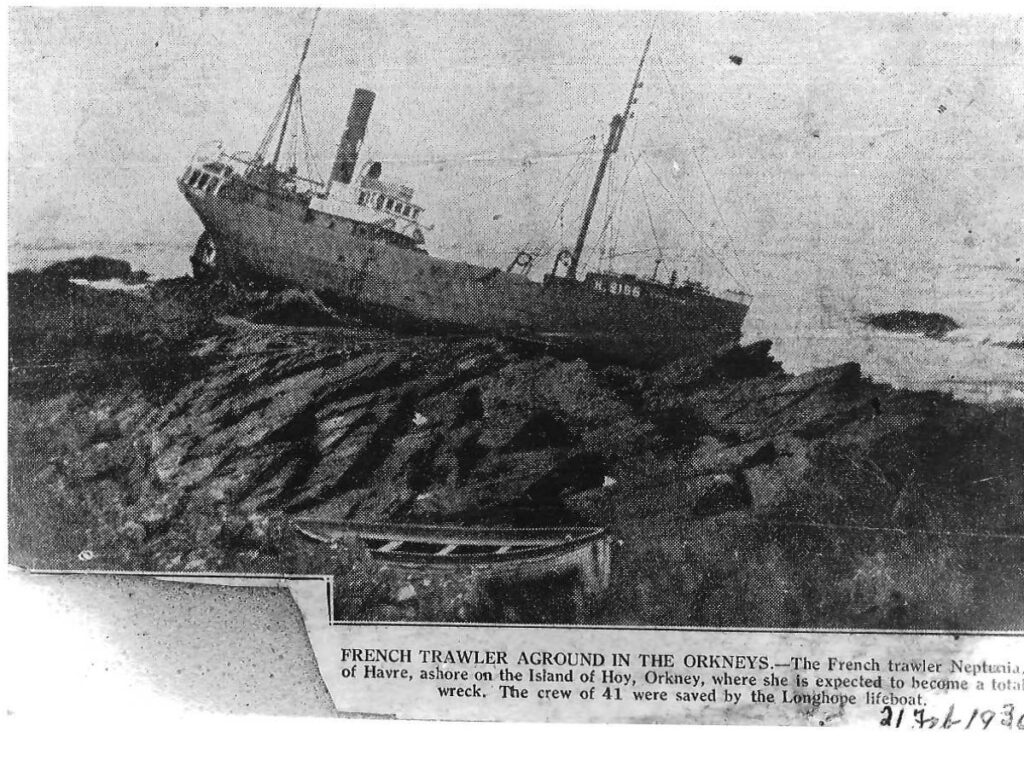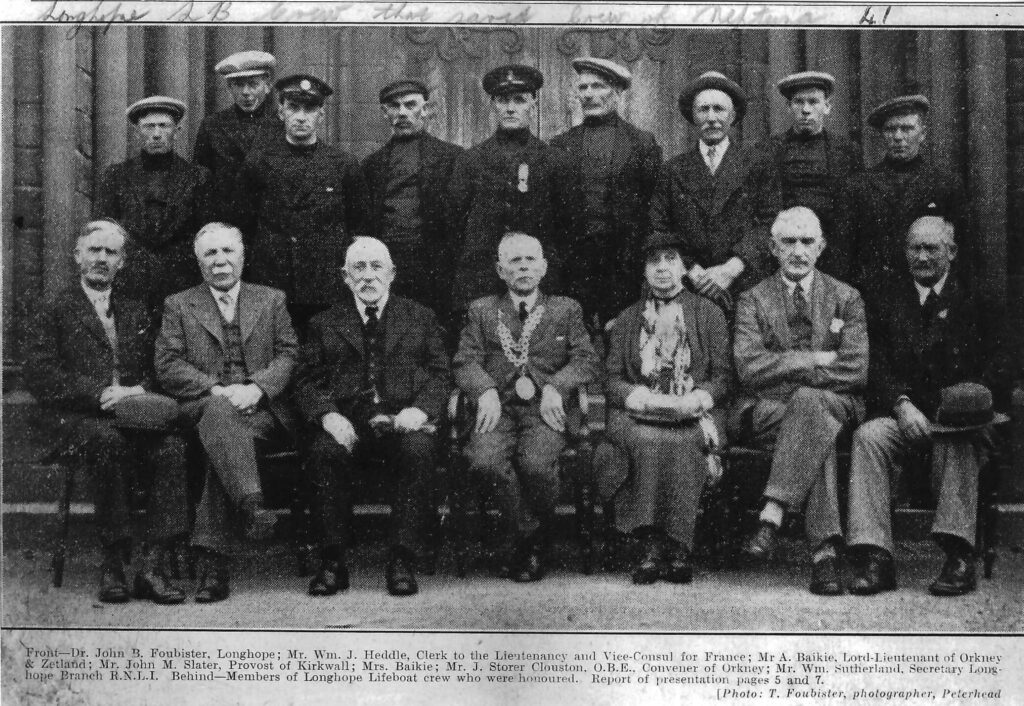“Eight Longhope heroes honoured at Kirkwall”; “Medal and Diploma Awards from French Government”. Three of the headlines and sub-headlines in the Orkney Herald, 14 October 1936. What had they done and why were they being honoured?
The events of Friday 21 February 1936
On the evening of 21 February 1936 the French steam trawler Neptunia, of Le Havre, ran aground on the Kittack rock at Brimsness in the island of Hoy, Orkney. (Map here) About 7pm Robert Johnston, Ferryhouse, a lifeboat crew member, spotted the ship close to the west side of Brimsness, then later aground close to his brother’s farm. “He immediately ran to the engineer’s house, fired the signal rocket, and sent word to the local secretary Mr Wm Sutherland, who sent the bus for the lifeboat crew”.
The lifeboat, Thomas McCunn, was not back on station having returned only a few hours earlier from taking an urgent appendicitis case to hospital in Kirkwall as the sea was too rough for any other boat. At 7.40pm the Thomas McCunn set out. It was fortunate that the crewman spotted the Neptunia for the position she gave in her distress signal was about ten miles out.
The rescue
The lifeboat crew found the Neptunia lying on a reef in a dangerous position with her stern jutting up and the bow submerged in deep water. Neptunia’s crew had launched their boats which lay alongside. The lifeboat dropped an anchor some distance from the Neptunia and, paying out a cable, veered as close as possible. They then fired a line aboard the Neptunia with a rocket gun and a heavy rope was then paid out. The Neptunia’s crew got into one of their small boats in relay, and the small craft was hauled out to the lifeboat. After several trips [four according to the Orkney Herald] had been made by the small boat the Neptunia’s crew of 41 were all brought safely aboard the lifeboat despite heavy seas….
Five minutes after the last man was on board the lifeboat the stranded trawler was lifted bodily by a wave and slid off the submerged rock on which she had stranded. She sank to the stern, a part of which remained visible in the glare of the searchlight. The lifeboat returned to Longhope at 10.30pm. The Frenchmen were hospitably entertained at the Longhope hotel.
Dundee Evening Telegraph, 22 February 1936, p 1.
Some reports state that the searchlight from the Fisheries cruiser Norna was instrumental in the rescue but the Orkney Herald, 4 March 1936, confirmed this was not so as she arrived on the scene after the lifeboat had rescued all the men. The Longhope life-saving apparatus team went by land to the trawler but decided that “owing to the jagged rocks and boiling surf which intervened between the trawler and the shore” a breeches buoy rescue was too dangerous.
All saved
Not a single person perished that stormy night. Bound for the Iceland fishing grounds, the Neptunia carried floating fish factory staff in addition to her own crew, hence the 41 men on board. The lifeboat, the Thomas McCunn, must have been very heavily laden therefore in addition to her own crew of eight; the biggest rescue accomplished by a Longhope lifeboat up to that point, perhaps ever. The Neptunia was a write-off.

The arrival of 41 Frenchmen who spoke no English and some of them needing shoes and socks was something of a problem but Mr Millar, an electrical engineer at the Post Office, Mr Seatter MA [the South Walls schoolmaster?] and Frank Meiklejohn [West Rinnigall, later Customhouse, Longhope] all came to the assistance as did JMF Groat’s shop. On Saturday 22 February they all left for Aberdeen via Stromness en route for France.
There were two more unusual escapees from the ship: a pig and a cat. Robert Johnston, Ferryhouse, Brims, caught the pig after two days but then it had to be shot due to quarantine regulations. 1Dundee Courier, 25 February 1936, p 6, column 3; Orkney Herald, 4 March 1936, p 4, column 2. The cat and its descendants lived on in Brims for quite a few years.
The details here are mainly from the reports in the Orkney Herald on 26 February 1936 and 4 March 1936 and the Dundee Evening Telegraph 22 February 1936; I would be grateful for any additions or amendments. For local memories of the rescue see two posts on Orkney Image Library here and here too.
Third callout
With the hospital case, it was the lifeboat’s third shout in 60 hours for on Wednesday 7 October, she had searched for the Merrivale, a Grimsby trawler wrecked on the Pentland Skerries. The ten-man crew all perished.
Recognition
In gratitude for the rescue, the French Government awarded each of the crew a diploma and a medal, silver for coxswain William Dass, and bronze for rest of the crew: George Johnston, bowman, Robert Johnston, engineer, Robert Johnston, crewman, Eric Mowat, 2nd mechanic, Sinclair Mowat, 2nd coxswain, John Norquoy, crewman, John Robertson, crewman, The formal presentation took place in Kirkwall later in the year.
Celebrations in Kirkwall and at home

On Friday 9 October, Longhope was “en fête” for the day when at 9am the lifeboat complete with coxswain, crew, officials, members of the committee, wives “and lady friends” set off from the pier for Scapa. Arriving there at 10.30am they made their way into Kirkwall, around one and a half miles away, for the formal reception and presentation at 11.30am at the Town Hall, the Orkney Herald related. There a crowd of around 500 people, including 230 pupils from Kirkwall Grammar School, was waiting for the crew.
It was certainly a gathering of the great and good of Orkney: Alfred Baikie, Lord-Lieutenant of Orkney, and his wife; WJ Heddle, French Vice-Consul in Orkney; Provost John M Slater, Kirkwall; J. Storer Clouston, County Convenor. There were the usual speeches lauding the crew and Mr Heddle, the French Vice-Consul the event’s organiser, translated the diplomas. In addition to Dr John Foubister and William Sutherland, Longhope Lifeboat secretary, three other Lifeboat committee members were present, Hugh Seatter, Robert Cutt and Anderson Sutherland, along with John R Doull, Longhope agent for the Shipwrecked Mariners’ Society.
The diplomas

Dr John B Foubister, the local doctor, replied on behalf of the lifeboat crew whom he described as “men of action, of deeds, not words”.
After the ceremony there was a champagne and cake reception for the crew, lifeboat officials and the platform party.
And time for a photo – at the door of St Magnus Cathedral I would say. This photo shows the crew, including former coxswain John (Jake) Swanson who received a long service medal, and the platform party. It’s interesting that the crew were not named in the photo while the dignitaries were.

Source: Orkney Library & Archive. Again I think this is one of my father’s newspaper clippings.
The crew, officials and friends then made their way back to Scapa where the lifeboat was open to visitors until 3pm; “large crowds” made their way there. In the evening, after their return to Longhope, there was a highly successful whist drive and dance in the YMCA hall to celebrate.
This is a post on the Society for One-Place Studies December prompt #OnePlaceCelebrations. I’m grateful to folk who know the story far better than me for supplying additional information. If you have any other recollections of this rescue and the ensuing awards and celebrations as told by now gone members of the community I’d be very grateful if you could add them in comments below so that they are not lost.
- Thomas McCunn lifeboat – at Longhope 1933-1962; now back there in the Longhope Lifeboat Museum.
- Rescue of the Ben Barvas 1964.

